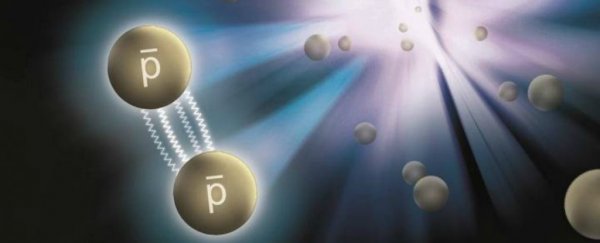For the first time, physicists in the US have managed to measure the force that attracts antimatter particles to each other. And, surprisingly, it's not that different to the attractive force that holds regular matter together.
The results take us one step closer to understanding one of the biggest mysteries of our Universe: why there's so much more matter than antimatter, and suggest that the imbalance isn't a result of antiparticles not being able to 'stick' together.
For every particle that exists – electrons, protons, quarks – there's an equal and opposite antiparticle, which has the opposite electrical charge and spin, and these antiparticles make up what's known as antimatter. When the Universe was formed, physicists believe that equal amounts of antimatter and matter were produced, but today it's very hard to find any naturally occurring antimatter left.
That's a good thing, because when antimatter and matter interact they annihilate each other, so we probably wouldn't be here if there was any more antimatter to contend with. But it's also confusing, because physicists can't work out why all the antimatter, but not regular matter, disappeared.
For decades scientists have been working on understanding the behaviour of antiparticles, which is a challenge in itself. Because there's so much regular matter everywhere, antimatter quickly gets destroyed. So far, physicists have been limited to creating a few anti-hydrogen atoms at a time.
But now a team at Rice University in the US has managed to create antiprotons by smashing together heavy gold ions, and has figured out how to measure the force that attracts antiprotons to each other for the first time.
To do this, they measured the scattering length – which is how much particles deviate as they travel from source to destination – and the effective range of interaction between two antiprotons, which is how close together antiprotons have to be before they start affecting each other, like magnets.
Once the team had these measurements, they were able to compare the attractive force between antiprotons and regular protons. "This is about the subtle difference in the way matter and antimatter interact with each other," said Frank Geurts, one of the lead researchers from Rice University.
Their results show that, interestingly, the attractive forces aren't actually that different at all. And that rules out some leading hypotheses for the imbalance of the two types of matter throughout the Universe.
"It could have been that antimatter didn't have the same attractive force as matter and would have helped explain how these differences, during the initial part of the Big Bang, might have resulted in antimatter not having survived in the shape of stars and planets, as matter did," said Geurts.
"That's where this research is helpful. The interactions between two antimatter particles turn out to be quite similar to matter particles. It may not give us a solution to the bigger problem, but we most definitely removed one option," he added.
For those playing along at home, the scattering length of antiprotons was 7.41 femtometres, and the effective range was 2.14 femtometres – nearly identical to their proton counterparts. To put into perspective how precise those measurements are, a femtometer is one-millionth of a nanometre (which is one-billionth of a metre).
"This discovery isn't a surprise," said Kefeng Xin, a PhD student who conducted the majority of the calculations. "We've been studying the interaction between nucleons (particles that make up an atom's nucleus) for decades, and we've always thought the forces between antimatter particles are the same as for matter. But this is the first time we've been able to quantify it."
So now that we know antiparticles are attracted to each other just as much as regular particles are, and that the imbalance in the Universe isn't the result of some kind of inability to bind together, what else could explain the lack of antimatter in the Universe? The answer isn't so simple, as the BBC explains:
"For example, neutrinos (another fundamental building block of the Universe) might be their own antiparticles. Differences in the way neutrino particles interacted after the Big Bang might have led to a slight matter excess that allowed our Universe to exist."
We're still a long way off knowing exactly what happened to get rid of most of the Universe's antimatter, but every time we find out more about these mysterious particle, it takes us one step closer. We can't wait to find out more.
The results have been published in Nature.

